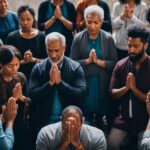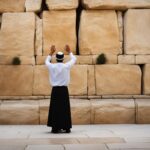The history of prayer kneelers is a captivating journey that spans centuries and encompasses various cultural and religious traditions. These humble pieces of furniture have witnessed the evolution of worship practices and have played a significant role in shaping the spiritual experiences of countless individuals.
From their origins in ancient Christian worship to their present-day existence in churches and religious spaces, prayer kneelers hold immense historical and cultural significance. They have evolved alongside changing religious practices and societal norms, embodying the values of devotion, reverence, and community.
Key Takeaways:
- Prayer kneelers have a rich legacy that spans centuries and various cultural and religious traditions.
- They originated in ancient Christian worship and have evolved over time.
- Prayer kneelers symbolize devotion, humility, and a connection to the divine.
- Vintage and antique prayer kneelers carry a sense of nostalgia and historical significance.
- Prayer kneelers contribute to the overall aesthetics and sacred atmosphere of religious spaces.
Origins of Prayer Kneelers
Prayer kneelers have a long and fascinating history that dates back to the early centuries of Christianity. During this time, there is no evidence of churches having any seating arrangements. Instead, parishioners would stand, kneel, or move about the nave during worship. The concept of sitting in chairs during religious services only emerged around the time of the Protestant Reformation, marking a significant shift in the practices of worship.
The origins of prayer kneelers can be attributed to the desire for comfort and convenience during prayer. As the tradition of sitting during worship became more common, there arose a need for a designated space where individuals could kneel and engage in prayer. Thus, the idea of prayer kneelers was born, providing a physical support for the act of kneeling and creating a more structured and focused environment for prayer.
Throughout history, the design and use of prayer kneelers have evolved in response to changing religious practices and societal norms. From their humble beginnings as simple cushions or pads to the more elaborate and ornate designs seen in medieval churches, prayer kneelers have adapted to reflect the cultural and artistic preferences of different periods.
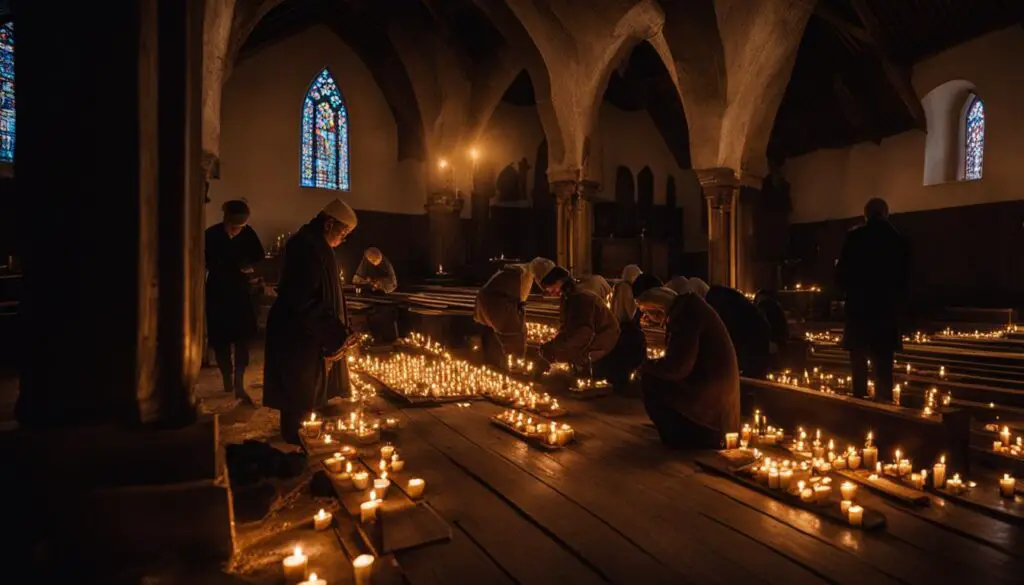
“The origins of prayer kneelers are rooted in the changing practices of worship and the desire for comfort and convenience.”
Today, prayer kneelers continue to be used in religious spaces around the world, serving as a physical reminder of the importance of prayer and creating a reverent atmosphere for worship. The origins of prayer kneelers provide us with a deeper understanding of their significance within religious traditions and offer a glimpse into the ways in which religious practices have evolved over time.
Evolution of Prayer Kneelers
The design and purpose of prayer kneelers have evolved significantly over time, reflecting changes in religious practices and the desire for inclusivity in worship spaces.
In the early days of church seating, the concept of pews resembled luxury skyboxes known as “box pews.” These elaborate enclosures featured walls, doors, windows, and even tables and fireplaces. The wealthiest families in the congregation owned and paid for these box pews, creating a hierarchy of seating. Prayer kneelers were an essential component of these box pews, providing a comfortable and designated space for individuals to kneel during worship.
However, as societal norms shifted towards more egalitarian values, the design of church seating underwent a transformation. The extravagant box pews gradually gave way to simpler wooden benches, symbolizing a move towards a more inclusive and communal worship experience. This evolution allowed for equal seating opportunities for all parishioners, regardless of their socio-economic status, fostering a sense of unity and equality within the congregation.
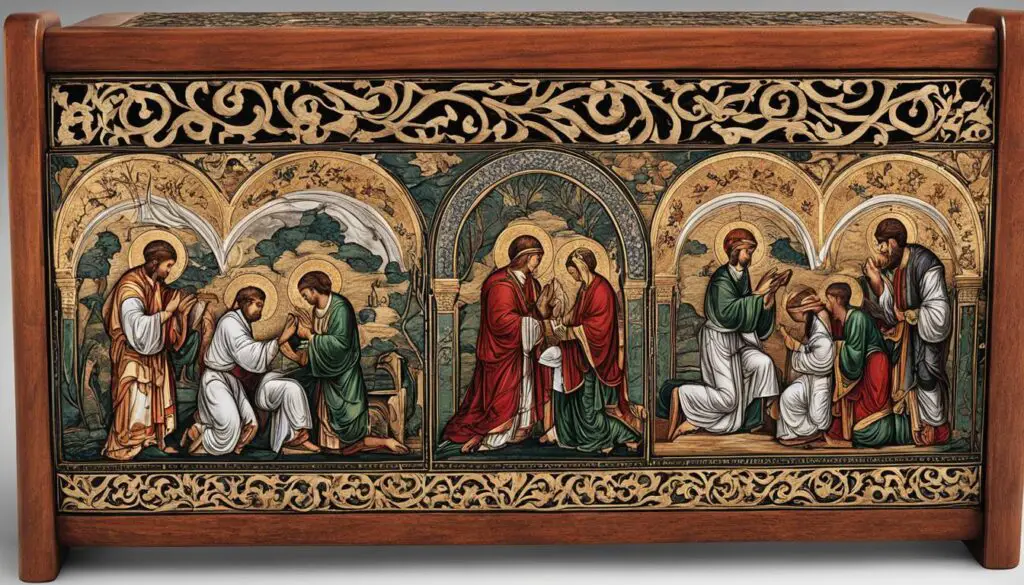
Today, the wooden benches we see in churches are a testament to the evolution of prayer kneelers. These benches provide a common space for worshippers to kneel and engage in prayer, emphasizing the shared spiritual journey of the community. They eliminate the distinctions created by the ownership of box pews, fostering a more inclusive and harmonious worship environment.
As we explore the rich history of prayer kneelers, it becomes evident that their evolution reflects not only the changing dynamics of religious practices but also the deep-rooted human desire for unity and equality in worship. The transition from box pews to wooden benches signifies a remarkable shift towards a more inclusive and communal approach to faith, enabling individuals to connect with their spirituality in a cohesive and harmonious setting.
Historical Development of Prayer Kneelers
The historical development of prayer kneelers is deeply intertwined with the changes in religious practices and societal norms over time. As the construction and maintenance of churches became more expensive, the sale and rental of pews, including prayer kneelers, emerged as a means of generating funds. However, this practice also led to the creation of a hierarchical and exclusive environment within the church community, which drew criticism from clergy and some members.
Eventually, there was a shift towards a more egalitarian approach to worship, and the ownership of pews, including prayer kneelers, became less common. This marked a significant turning point in the historical development of prayer kneelers, as wooden benches replaced pews and kneelers, creating a more inclusive and communal worship experience.
Vintage and Antique Prayer Kneelers
Immerse yourself in the enchantment of prayer kneelers from bygone eras. These vintage and antique pieces hold a treasure trove of nostalgia and historical significance. Each one is a tangible connection to the past, offering a glimpse into the enduring legacy of prayer kneelers in religious practice.
Step back in time as you discover the ornate designs and intricate carvings that adorn vintage prayer kneelers. These exquisite masterpieces evoke a sense of wonder, showcasing the craftsmanship and artistry of bygone artisans. With every touch and gaze, you’ll be transported to an era steeped in reverence and devotion.
Antique prayer kneelers, on the other hand, carry not only sentimental value but also potential collectible worth. These rare artifacts are sought after by collectors and enthusiasts alike, their historical significance captivating the hearts of those who appreciate the timeless beauty of these unique pieces.
Vintage vs. Antique Prayer Kneelers
| Vintage Prayer Kneelers | Antique Prayer Kneelers |
|---|---|
| Feature ornate designs and carvings | Potential collectible value |
| Embody a sense of nostalgia | Sentimental and historical significance |
| Showcase craftsmanship and artistry | Rare artifacts sought after by collectors |
Whether you’re a collector, an admirer of history, or simply drawn to the beauty of vintage and antique pieces, prayer kneelers from earlier periods offer both visual delight and a connection to the past. Let these remarkable artifacts grace your space, infusing it with a touch of reverence and a profound appreciation for the rich history of prayer kneelers.
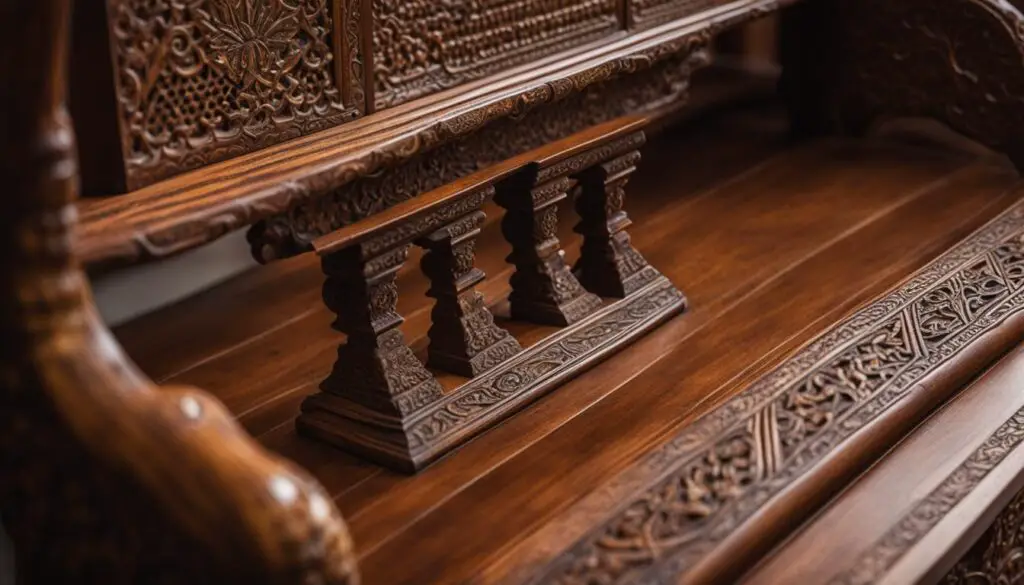
Traditional Prayer Kneelers
Traditional prayer kneelers, similar to the wooden benches found in churches today, are a common sight in religious spaces. These kneelers provide a designated place for individuals to kneel and engage in prayer during worship services. In some traditions, prayer kneelers are also used during personal devotional practices. The use of traditional prayer kneelers helps to create a reverent and focused environment for prayer and reflection.
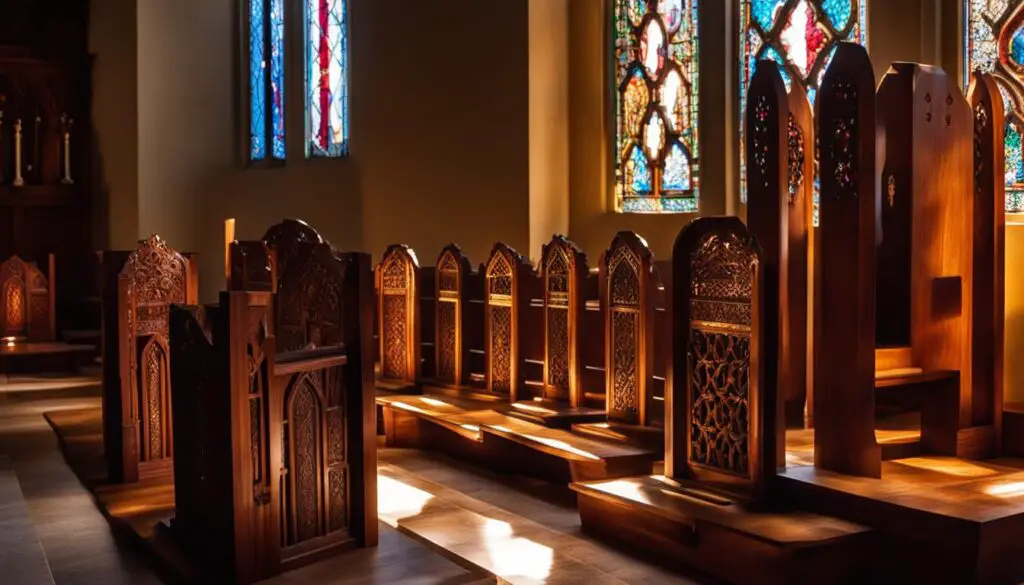
Cultural Importance of Prayer Kneelers
Prayer kneelers hold a deep cultural significance within various religious communities and traditions. They go beyond being mere pieces of furniture, serving as tangible symbols of devotion and reverence. When individuals kneel on a prayer kneeler, they embody an act of humility and submission, signifying their spiritual journey of devotion to a higher power.
These sacred objects play a crucial role in reminding worshippers of their connection to the divine. As individuals kneel in prayer, they enter a state of introspection and spiritual connection, fostering a deeper understanding of their faith. The presence of prayer kneelers contributes to the overall aesthetics and ambiance of religious spaces, creating an atmosphere of solemnity and reverence.
“The act of kneeling on a prayer kneeler is not just about physical positioning; it represents a deeply rooted cultural practice that transcends generations.”
The cultural importance of prayer kneelers extends beyond the individual worshipper. They also hold significance within religious communities as a whole. For centuries, prayer kneelers have been a visual symbol of faith and a unifying element within congregations. Their presence in churches, chapels, and other places of worship serves as a powerful reminder of shared beliefs and a collective journey towards spiritual enlightenment.
Furthermore, the cultural significance of prayer kneelers is not limited to a particular religious tradition. While they are widely seen in churches, prayer kneelers can also be found in other religious spaces such as mosques, synagogues, and temples. This highlights their universal appeal as symbols of devotion and spiritual connection.
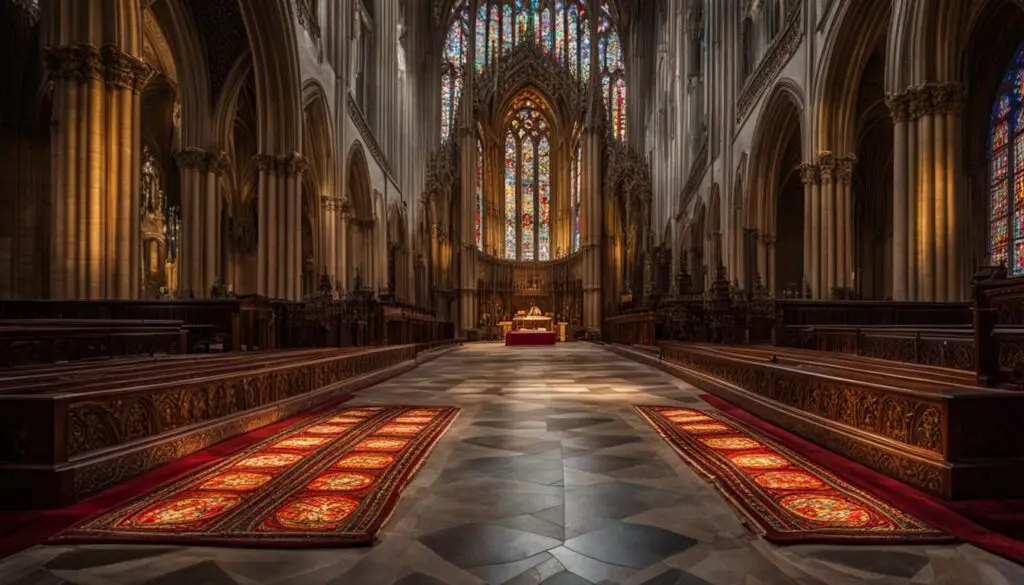
As we reflect upon the cultural importance of prayer kneelers, it becomes evident that they are more than just objects of furniture. They embody centuries of tradition, spirituality, and communal worship. The use of prayer kneelers not only enhances the worship experience but also serves as a constant reminder of the devotion and reverence that is inherent in religious practice.
Significance of Prayer Kneelers
The significance of prayer kneelers goes beyond their physical presence in religious spaces. These humble pieces of furniture play a profound role in creating a sacred and contemplative atmosphere for prayer and reflection. Let’s explore the deep meaning behind the use of prayer kneelers.
Prayer kneelers provide a designated area for individuals to kneel, allowing them to concentrate their thoughts and intentions. By creating a physical space for prayer, these kneelers serve as a gentle reminder of the importance of spiritual practice in one’s life.
When individuals kneel on prayer kneelers, they experience a sense of grounding and connection with a higher power. The act of kneeling symbolizes humility and submission, acknowledging the profound relationship between humanity and the divine.
“The act of kneeling on a prayer kneeler becomes a transformative moment of surrender, allowing individuals to open their hearts and minds to the divine presence.”
During times of worship, prayer kneelers offer a sense of comfort and support to individuals. They provide a stable surface to rest upon while engaging in prayer, alleviating physical strain and allowing worshippers to fully focus on their spiritual connection.
In addition to their practical function, prayer kneelers are symbols of faith and devotion. They serve as gentle prompts, inviting individuals to engage in prayer and connect with their spiritual selves. The presence of prayer kneelers in religious spaces fosters a deeper sense of reverence and spiritual awareness.
Benefits of Using Prayer Kneelers:
- Enhances Focus: By providing a dedicated space for prayer, kneelers help individuals minimize distractions and immerse themselves in their spiritual practice.
- Deepens Spiritual Connection: Kneeling on prayer kneelers creates a physical manifestation of reverence, strengthening the bond between worshippers and their faith.
- Fosters Unity: Shared act of kneeling on prayer kneelers fosters a sense of communal worship, promoting a shared experience of devotion and prayer.
- Promotes Posture and Alignment: Prayer kneelers encourage individuals to adopt a proper posture, promoting physical comfort and alignment during extended periods of prayer.
Ultimately, the significance of prayer kneelers lies in their ability to facilitate a deep and meaningful connection with the divine. They serve as physical and spiritual anchors, inviting individuals to kneel, open their hearts, and find solace in prayer.
The Evolution and Impact of Prayer Kneelers
The evolution of prayer kneelers has been closely intertwined with the changing dynamics of worship and the desire for inclusivity and equality in religious spaces. Throughout history, these humble pieces of furniture have played a significant role in shaping the physical and spiritual experiences of worshippers.
From the elaborate box pews of the past to the simpler wooden benches we see in churches today, prayer kneelers have undergone remarkable changes. In the early centuries of Christianity, churches had no seating at all, and parishioners would stand, kneel, or move about during worship. However, with the emergence of the Protestant Reformation, the concept of sitting in chairs for worship began to take hold.
Over time, the design and purpose of prayer kneelers continued to evolve. The luxurious box pews, which were owned by the wealthiest families in the congregation, gave way to more egalitarian wooden benches. These benches were accessible to everyone and fostered a sense of community during worship, reflecting a desire for inclusivity and equality.
Today, prayer kneelers serve as a physical space for individuals to kneel and engage in prayer during worship services. They provide a designated area for devotees to focus their thoughts and intentions, creating a reverent and focused environment for prayer and reflection.
The impact of prayer kneelers extends beyond the physical realm. These pieces of furniture carry cultural and historical significance, serving as tangible symbols of devotion and reverence. The act of kneeling on a prayer kneeler is seen as a sign of humility and submission, reflecting the spiritual journey of devotion. Through their presence, prayer kneelers contribute to the overall aesthetics and ambiance of religious spaces, adding to the sacred atmosphere.
By understanding the evolution and impact of prayer kneelers, we gain a deeper appreciation for their significance in religious traditions. These humble pieces of furniture have not only provided physical comfort and support but have also shaped the way individuals engage with their faith and fostered a sense of community. The legacy of prayer kneelers continues to inspire worshippers around the world.
| Style | Description | Features |
|---|---|---|
| Vintage | Prayer kneelers from earlier periods of history | Ornate designs and carvings |
| Antique | Prayer kneelers considered valuable collectibles | Significant historical value |
| Traditional | Common wooden benches found in churches today | Simple and functional design |
Conclusion
The history of prayer kneelers is a testament to the rich legacy of religious practice and devotion. These humble pieces of furniture have come a long way since their early origins in ancient Christian worship. From the simple act of standing and kneeling during worship to the evolution into the wooden benches we see in churches today, prayer kneelers have played a significant role in shaping religious traditions throughout history.
Prayer kneelers hold deep cultural and historical importance, serving as symbols of faith, humility, and reverence. They provide a physical and mental space for prayer and reflection, allowing individuals to connect with a higher power and foster a deeper sense of devotion. Over time, prayer kneelers have evolved from elaborate box pews to more inclusive and communal wooden benches, reflecting a desire for egalitarian worship experiences.
Understanding the history of prayer kneelers offers a deeper appreciation for their significance in religious traditions. They continue to be cherished artifacts, evoking nostalgia and reminding us of the rich legacy of prayer kneeler history. As they stand as silent witnesses to centuries of devotion and worship, prayer kneelers inspire us to maintain our faith, embrace humility, and seek connection with the divine.
FAQ
What is the history of prayer kneelers?
The history of prayer kneelers dates back to early Christianity, where churches did not have seating. The concept of sitting in chairs for worship emerged around the time of the Protestant Reformation, leading to the evolution of prayer kneelers.
How did prayer kneelers evolve?
Prayer kneelers started as luxury “box pews” owned by wealthy families in the congregation. Over time, wooden benches replaced box pews, providing a more inclusive and communal worship experience.
What is the significance of vintage and antique prayer kneelers?
Vintage and antique prayer kneelers carry a sense of nostalgia and historical significance. They can feature ornate designs and carvings, and antique prayer kneelers can be valuable collectibles, connecting individuals to the past.
How are traditional prayer kneelers used?
Traditional prayer kneelers are commonly seen in religious spaces, providing a designated place for individuals to kneel and engage in prayer during worship services. They create a reverent and focused environment for prayer and reflection.
What is the cultural importance of prayer kneelers?
Prayer kneelers hold cultural importance in various religious communities and traditions. They serve as tangible symbols of devotion and reverence, adding to the overall aesthetics and ambiance of religious spaces.
What is the significance of prayer kneelers?
Prayer kneelers create a physical and mental space for prayer and reflection. They serve as reminders of the importance of spiritual practice, offering comfort and support during worship. They are symbols of faith and devotion in religious traditions.
Source Links
- https://www.christianitytoday.com/ct/1981/october-23/legacy-of-rochester-revivals.html
- https://folkways.si.edu/magazine-fall-winter-2014-singing-praying-bands-maryland-delaware/gospel-african-american-sacred/music/article/smithsonian
- https://christandpopculture.com/history-pews-just-terrible-embarrassing-youd-imagine/







